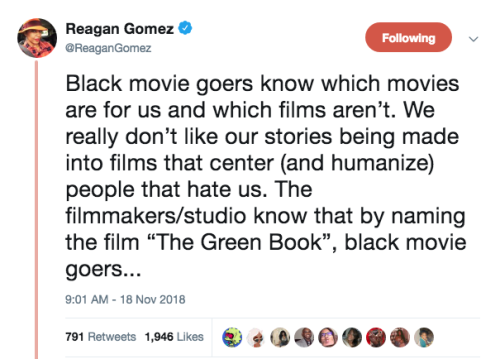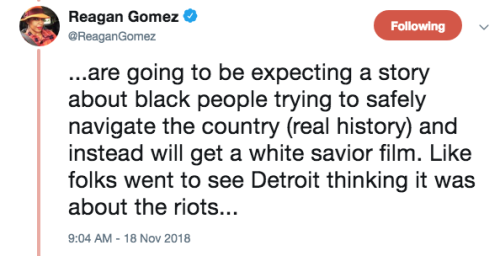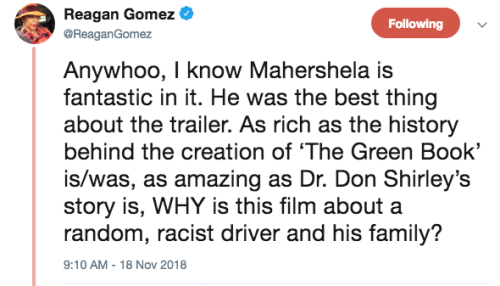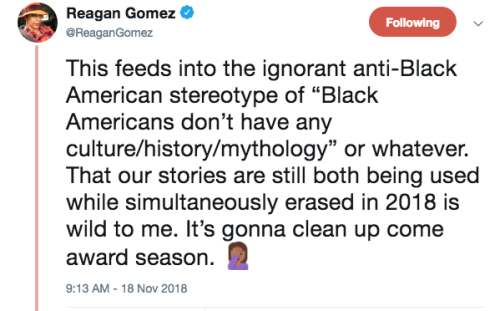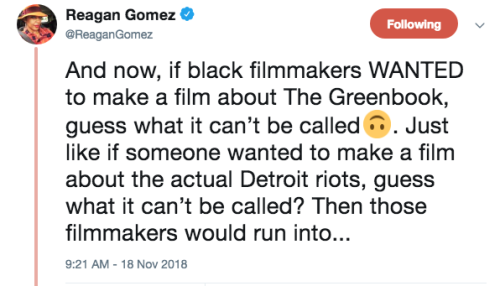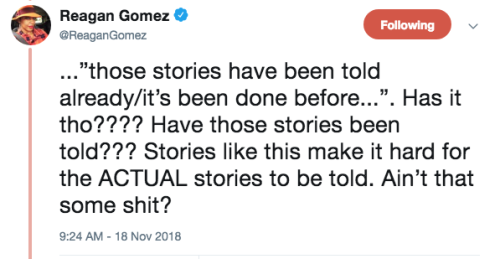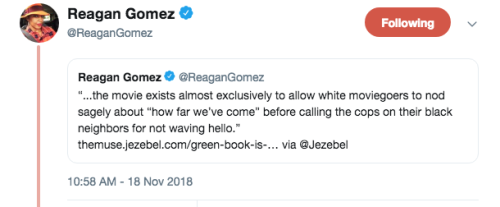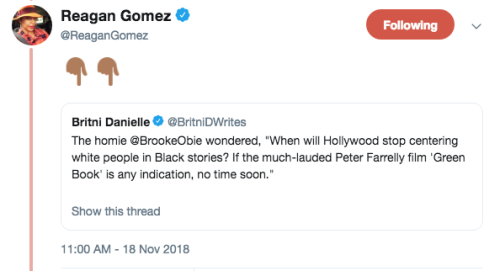thechanelmuse:Viggo Mortensen Apologizes for Using N-Word During ‘Green Book’ Panel'Green Book’ Is A
thechanelmuse:Viggo Mortensen Apologizes for Using N-Word During ‘Green Book’ Panel'Green Book’ Is A Poorly Titled White Savior FilmWhen will Hollywood stop centering white people in Black stories? If the much-lauded Peter Farrelly film Green Book is any indication, no time soon. The film supposedly gets its title from The Negro Motorist Green Book, an iconic Black travel guide published from 1936-1966 by Victor Hugo Green and his wife Alma Green. Green was a well-connected Black mailman whose Green Book documented restaurants, hotels, gas stations and more that Black travelers and vacationers could safely use while traveling throughout the country – from the segregated Jim Crow South to his hometown in New York City. The north was no safe space for Black people and Green and his book show that. “Carry your Green Book with you—You may need it,” the cover of the book urged its readers. And carry it they did. Just not in this ahistorical film. Green Books deserved Better. In Farrelly’s Green Book, Black people don’t even touch the Green Book, let alone talk about its vital importance to their lives. Instead, the film centers the story of a racist white man who makes an unlikely Black friend on a journey through the American south and becomes slightly less racist. In this reverse-Driving Miss Daisy film, Viggo Mortensen stars as Tony Lip, an Italian American bouncer hired to drive and protect Mahershala Ali’s queer, Jamaican-American classical pianist Dr. Don Shirley on a concert tour from Manhattan down to the deep south. The first mention of the Negro Motorist Green Book in the film is when a white representative from Dr. Shirley’s record company pulls Lip aside to hand him a copy and explain that Lip will need it to know where he can safely take Dr. Shirley on this trip down south. “Three years ago when we started writing this thing, no one knew about it –not no one, obviously, but nobody I knew,” Farrelly told Shadow and Act about why he chose to title his movie Green Book. “White people didn’t know about it, I didn’t know about it, and most of the Black people that I spoke with didn’t know about,” he said. And you still won’t know about it after watching this movie, because the Green Book, much like the film, only exists as a prop to enhance white understanding of white racism and white privilege in this country. But that understanding is limited because this story is told from Tony Lip’s perspective. And, again, Tony Lip is a racist. We see how racist Lip is as he lets anti-Black pejoratives like “eggplant” hang from his lips as easily as the cigarettes he chainsmokes. When two Black service workers enter his home and drink beverages from glasses Lip’s wife offered to them, Lip promptly takes their empty glasses out of the sink and throws them in the garbage can so no one in his home will have to use the same glass Black people used once. Because the bar for a racist’s growth is beneath the floor, the audience is meant to use this scene as a benchmark to tell how far he’s come by the end of the film when he and Dr. Shirley become lifelong friends. But a racist’s relationship with individual Black people is not the same as being anti-racist. Ask Sally Hemmings. So, Lip’s racism must also be the lens through which we view the details of this story, as well. Though the Green Book he shuffles through for Dr. Shirley promises comfortable hotels, through Lip’s eyes, the motels he finds are not cozy homes away from home but rundown slums crawling with stray cats and dice-shooting Black people. Lip even remarks to himself that the Green Book is essentially offering false advertising to its desperate consumers. On a press call about the Negro Motorist Green Book with Maira Liriano, Associate Chief Librarian of the Schomburg Center for Research in Black Culture–which holds the largest collection of Green Books in the country–Liriano strongly disputed this characterization to Shadow and Act: “I’ve never heard that, in the years that I’ve been working with researchers and scholars studying the Green Books, I’ve not encountered ‘false advertising’ within the Green Books. So I don’t think that was very accurate,” Liriano says. “I’m not saying every single place was wonderful and fabulous that was listed in the Green Books, but I feel like they don’t do it justice (in the film)." Mahershala Ali deserved better.But while the real Green Books don’t match their depiction in this film and the title doesn’t match the premise of the film, the movie poster most certainly is accurate. Mortensen is front and center on the poster and Green Book is his star vehicle. The brilliant Ali (and, therefore, Dr. Shirley) literally and figuratively takes a back seat. Read moreAbout the actual Green Book:The Green Book: The Black Travelers’ Guide to Jim Crow America“There will be a day sometime in the near future when this guide will not have to be published. That is when we as a race will have equal opportunities and privileges in the United States. It will be a great day for us to suspend this publication for then we can go wherever we please, and without embarrassment.”That was how the authors of the “Negro Motorist Green Book” ended the introduction to their 1948 edition. In the pages that followed, they provided a rundown of hotels, guest houses, service stations, drug stores, taverns, barber shops and restaurants that were known to be safe ports of call for African American travelers. The “Green Book” listed establishments in segregationist strongholds such as Alabama and Mississippi, but its reach also extended from Connecticut to California—any place where its readers might face prejudice or danger because of their skin color. With Jim Crow still looming over much of the country, a motto on the guide’s cover also doubled as a warning: “Carry your Green Book with you—You may need it.”First published in 1936, the Green Book was the brainchild of a Harlem-based postal carrier named Victor Hugo Green. Like most Africans Americans in the mid-20th century, Green had grown weary of the discrimination blacks faced whenever they ventured outside their neighborhoods. Rates of car ownership had exploded in the years before and after World War II, but the lure of the interstate was also fraught with risk for African Americans. “Whites Only” policies meant that black travelers often couldn’t find safe places to eat and sleep, and so-called “Sundown Towns”—municipalities that banned blacks after dark—were scattered across the country. As the foreword of the 1956 edition of the Green Book noted, “the White traveler has had no difficulty in getting accommodations, but with the Negro it has been different.” The Green Book’s listings were organized by state and city, with the vast majority located in major metropolises such as Chicago and Detroit. More remote places had fewer options—Alaska only had a lone entry in the 1960 guide—but even in cities with no black-friendly hotels, the book often listed the addresses of home owners who were willing to rent rooms. In 1954, it suggested that visitors to tiny Roswell, New Mexico, should stay at the home of a Mrs. Mary Collins.Read moreThen there’s this shit…‘Green Book’ Star Viggo Mortensen Apologizes For Using N-Word During Panel On Film: 'I Will Not Utter It Again’Mahershala Ali’s co-star in the racial dramedy Green Book, Viggo Mortensen, has issued an apology after it was revealed on Twitter that he used the N-word on a panel about the film Wednesday. The Q&A panel took place after the Film Independent Presents screening of the film at Arclight Hollywood. Mortensen was with Ali and director Peter Farrelly for the panel when he began to speak about racial progress in the country. “For instance, no one says n**ger anymore,” Mortensen said, per Film Independent member Dick Schulz. He spoke with The Hollywood Reporter on Thursday after his tweet began to gain traction. Schulz told The Hollywood Reporter, "It was all anyone was talking about when we left the theater. I was hearing everybody passing by me going up the stairs going, ‘That was crazy! Why did he say that? You cannot say that!’ And it’s sad because the movie is great. The irony is confounding, to be honest — it’s really shocking, and it was really shocking in the moment.” He explained that it happened during Mortensen using an example during a response to a question toward another panelist. “Viggo just started talking, and it got away from him quickly. He started talking about how, in this climate, the world today, progress isn’t going to happen quickly, it’s going to happen slowly, but the movie is going to mean a lot for a long time because we’re constantly coming up against racism and how racism is almost human nature and these things come in waves. And that’s when he went, ‘I’m gonna go off on a tangent here, but it’s important, and I don’t like saying the word, but, for instance, people don’t say’ — and then he said the N-word in its entirety — ‘anymore,’ and you could just feel the room immediately tense up. And the craziest thing was they had just talked about body language, so I felt like everyone was really attuned to body language, and everyone’s body language on the panel immediately tensed up.” “I think that he immediately regretted it,” Schulz added. “He went on for I don’t know how long it was — it felt like an eternity after that, because everyone was waiting for the answer to end, but he was trying to steer the ship back to where he was trying to go.” According to Schulz, “A woman shouted back at him, ‘Don’t say that,’ immediately after he said it.”Read more -- source link
Tumblr Blog : thechanelmuse.tumblr.com
